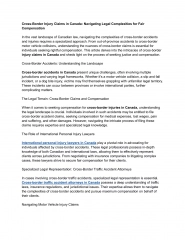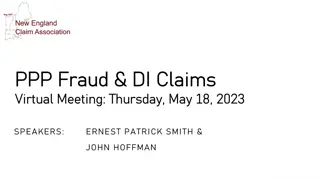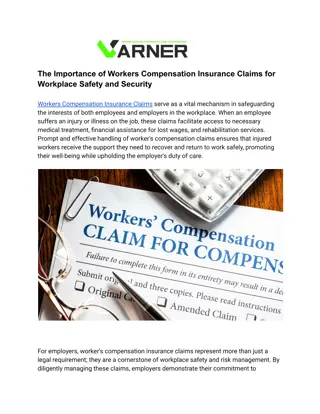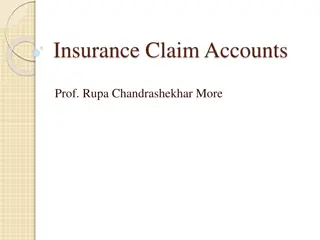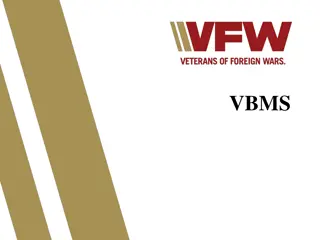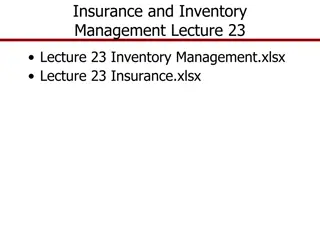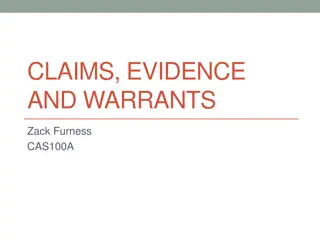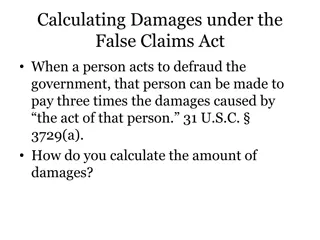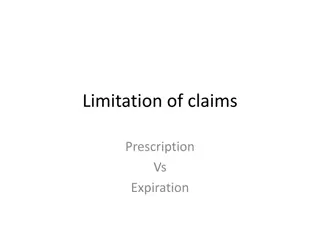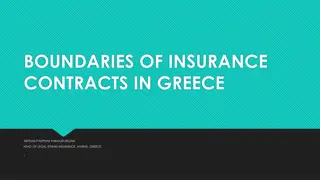Understanding Fraudulent Claims in Insurance: Key Legal Aspects
Explore the intricacies of fraudulent insurance claims through legal perspectives, including the impact of the Fraudulent Claims Rule, the 2015 Insurance Act, and the dichotomy between civil and criminal law in prosecuting insurance fraud. Delve into the ethical debates surrounding dishonest claims and the definition of fraud. Gain insights into prosecuting insurance fraud and the necessary legal definitions to combat such practices effectively.
Download Presentation

Please find below an Image/Link to download the presentation.
The content on the website is provided AS IS for your information and personal use only. It may not be sold, licensed, or shared on other websites without obtaining consent from the author. Download presentation by click this link. If you encounter any issues during the download, it is possible that the publisher has removed the file from their server.
E N D
Presentation Transcript
When a lie is dishonest but a claim isn t! by Jeff Heasman LL.B (Hons), LL.M @jhtrainingandconsulting @JHTCTweet
Learning outcomes Identify the key elements of the fraudulent claims rule as it relates to fraudulent devices. Understand and critically analyse the main aspects of the judgment of the Supreme Court in The DC Merwestone. Understand the relevant provisions of the Insurance Act 2015 and how these will impact on how an insurer may deal with fraudulent claims and the remedy available to an insurer. Apply the knowledge gained from the seminar to deal more effectively with, and find practical solutions to, claims involving a fraudulent device.
The scale of the problem Results in an additional 50 being added to the average annual household bill. In 2011, 139,000 dishonest claims totalling 1 billion. The insurance industry invests 200 million in fighting fraud. Source: ABI
Criminal law v civil law According to BBC reports in 2014, since its formation in 2011, the Insurance Fraud Enforcement Department has prosecuted 85 people. Is the civil law rather the criminal law being relied upon as a mechanism to deter and counter insurance fraud?
Are insurers fair game? The making of dishonest insurance claims has become all too common. There seems to be a widespread belief that insurance companies are fair game and that defrauding them is not morally reprehensible. Lord Justice Millett in Galloway v Royal Exchange (UK) Ltd [1999] Lloyd s Rep IR 209
What constitutes fraud? Whilst they had the opportunity to do so, when making recommendations for the Insurance Act 2015, the Law Commission decided it should be left to the courts to define fraud. Was this the correct approach?
The words of Lord Herschell have stood the test of time. Fraud will be proven when a false representation has been made: knowingly, or without belief in its truth, or recklessly, careless whether it be true or false. 1) 2) 3) Derry v Peek (1889) 14 App. Cas. 337
What about bargaining tools? Ewer v National Employers Mutual General Insurance Association [1937] 2 All ER 193 Mr Justice McKinnon didn t see much wrong with a claim for the cost of new furniture to replace second-hand furniture that had been destroyed. It was part of the opening negotiations and the claimant knew their claim would be scrutinised by assessors. Is the modern judiciary so tolerant?
Orakpo v Barclays Insurance Services [1995] LRLR 443. Lord Justice Hoffman stated: In cases where nothing is misrepresented or concealed, and the loss adjuster is in as good a position to form a view on the validity of the claim as the insured, it will be a legitimate reason that the insured was merely putting forward a starting figure for negotiation.
The Financial Ombudsman Service states that for fraud to be established there should be: concrete evidence of lies, inconsistent statements or acts of deception. Ombudsman News, Issue 21
How the courts have categorised claims 1) Wilful misconduct on the part of the insured, where the insured deliberately causes the loss and then makes a claim under the policy. 2) Losses which are invented by the insured when there has been no loss. 3) Presenting a claim to an insurer in a way that seeks to conceal the fact that the insurer may have a defence. 4) Exaggerating a claim that has arisen from a genuine loss. 5) Using a fraudulent device to improve the prospects of success in a claim where a genuine loss has occurred. Source: Macdonald Eggers P., Good Faith and Insurance Contracts, 3rdEd, (London: Lloyd s List Group, 2010)
When is a claim presented? According to one commentator, Professor D.R. Thomas, it is when a communication: represents the insured s concluded position and is an unequivocal assertion to the entitlement to an indemnity under the policy. What about preliminary notifications?
The duty not to present a fraudulent claim arises at the point the claim is presented and ends when court proceedings are commenced. At this point, the court rules will apply The Star Sea [2001] UKHL 1 What about forged documents submitted after settlement terms have been agreed? See Direct Line Plc v Fox [2009] EWHC 386
The fraud must be substantial The contentious issue here is when a claim consists of a genuine part and a fraudulent component. Galloway v Guardian Royal Exchange (UK) Ltd [1999] Lloyd s Rep IR 324 ( 2,000 of an 18,000 claim) Tonkin v UK Insurance Ltd [2006] EWHC 1120 ( 2,000 of a 700,000 claim). It s not about mathematics.
The burden of proof The burden of proof is on the insurer - Lek v Mathews (1927) 29 Lloyd s Rep 141 The normal civil standard of on the balance of probabilities applies but a higher degree of probability may be required for the more serious allegations Hornall v Newberger Products Ltd [1957] 1 QB 247
The insurers remedy The common law remedy is forfeiture of the entire claim presented by the fraudulent insured. The insured is required to repay interim payments Axa v Gottlieb [2005] Lloyd s Rep IR 369
Avoidance ab initio Think of section 17 of the Marine Insurance Act 1906. What about previously valid claims? Should a fraudulent claim tarnish previous claims made under the policy?
Self-help remedy Reduces the risks from the unpredictability of the common law. The insurer can stipulate their remedy.
Fraudulent devices the current battleground A fraudulent device is used when the insured believes that he has suffered the loss claimed but seeks to improve or embellish the facts surrounding the claim by some lie. Lord Justice Mance in The Aegeon [2002] EWCA Civ 247 Aviva Insurance Ltd v Brown [2011] EWHC 362
Sharons Bakery v Axa Insurance UK Plc [2011] EWHC 210 (Comm) The logic is simple. The fraudulent insured must not be allowed to think: if the fraud is successful, then I will gain; if it is unsuccessful, I will lose nothing. Lord Houbhouse in The Star Sea [2001] UKHL 1
The DC Merwestone Mr Justice Popplewell in the Commercial Court ([2013] EWHC 1666) reached the conclusion with regret that the claimant would lose their entire claim because they had used a fraudulent device. He drew a comparison with the criminal law: Not all fraud attracts the same moral obloquy, as is recognised in the sentencing practice applied to criminal offences involving dishonesty and fraud.
Mr Justice Popplewell also sought to rely on the judgment of Lord Justice Clarke from Fairclough Homes Ltd v Summers [2012] UKSC 26 A distinction between first party claims and third party claims.
Mr Justice Popplewell thought the issue was about being just and proportionate . ABI statistics doubted whether claims based on fraudulent devices represented a significant proportion of fraudulent claims.
Sanity was restored in the Court of Appeal. Lord Justice Christopher Clarke handed down the leading judgment on 16 October 2014 ([2014] EWCA Civ 1349). Fraudulent devices are a sub-species of the fraudulent claim rule. The drastic effect of forfeiture is what gives it its deterrent effect and its justification rests on that basis. The Human Rights Act 1998?
The Supreme Court handed down its judgment on 20 July 2016. Lord Sumption gave the leading judgment. By 4-1 the Supreme Court held that the fraudulent device rule does not apply to collateral lies . The lie must go to the recoverability of the claim on the true facts as found by the court. The opinion was that forfeiture of the entire claim is not a proportionate sanction it is possible for there to be a situation where a lie is dishonest but a claim isn t! The Insured gains nothing by telling it, and the insurer loses nothing if it meets a liability it always had. Lord Mancedissented he preferred a test of whether the lie yielded a significant improvement of the insured s prospects at the time the lie was told.
Fundamental dishonesty CPR 44.16 exceptions to qualified one-way costs shifting. Gosling v Screwfix Direct Ltd the dishonesty must go to the whole or a substantial part of the claim . Incidental or collateral dishonesty are excluded, though it need not relate to the entire claim. Section 57 of The Criminal Justice and Courts Act 2015. Applies to all personal injury claims where issued after 13 April 2015 and allows a defendant to seek dismissal of a claim where the claimant has an entitlement to damages (CPR 44.16 remains as an alternative). The court does not have to dismiss the claim if it would result in a substantial injustice (not defined). However, where the case is struck out, it is the entire claim, not just the dishonest part. The court will assess the amount it would have awarded had the claim not been dismissed and that amount is then deducted from the defendant s costs.
The Insurance Act 2015 The Law Commission made clear that they did not think it right that the Act should codify the law relating to fraudulent claims but instead should be used to provide clarity regarding the insurer s remedies. The definition of fraud and what constitutes fraud remains at the mercy of the common law.
The insurers remedies The insurer will not be liable where there is a fraudulent claim. Sums previously paid in respect of the fraudulent claim can be recovered. By serving notice, there is a remedy of prospective avoidance from the date of the fraudulent act and there is no need to return the premium (see section 13 for group policies) Previous claims are not impacted. Section 14 remedy of avoidance ab initio is abolished.
The new Act uses the term fraudulent act rather than claim. In a situation where a fraudulent act has been committed and payments are made because the insurer has not discovered it but they then go on to discover the fraudulent act there is no statutory remedy. The Law Commission recommend a self-help remedy of express provisions. Part 5 of the Act deals with contracting out especially in consumer contracts, an insurer cannot seek to impose a harsher penalty than is provided by statute. See also the transparency requirements. Third party claims are still not covered by the Act.
In summary We are still at the mercy of the common law the lie must be material (not collateral) and will be assessed on the facts as found by the court. Third party claims are not covered by the Insurance Act 2015 and little has changed but remember the remedy of prospective avoidance. The best advice is to use a self-help remedy!
Thank you and please stay in touch 3rdFloor, Capital Tower Greyfriars Road Cardiff CF10 3AZ +44 (0) 2921 660 283 info@jeffheasman.com www.jeffheasman.com @JHTCTweet @jhtrainingandconsulting


